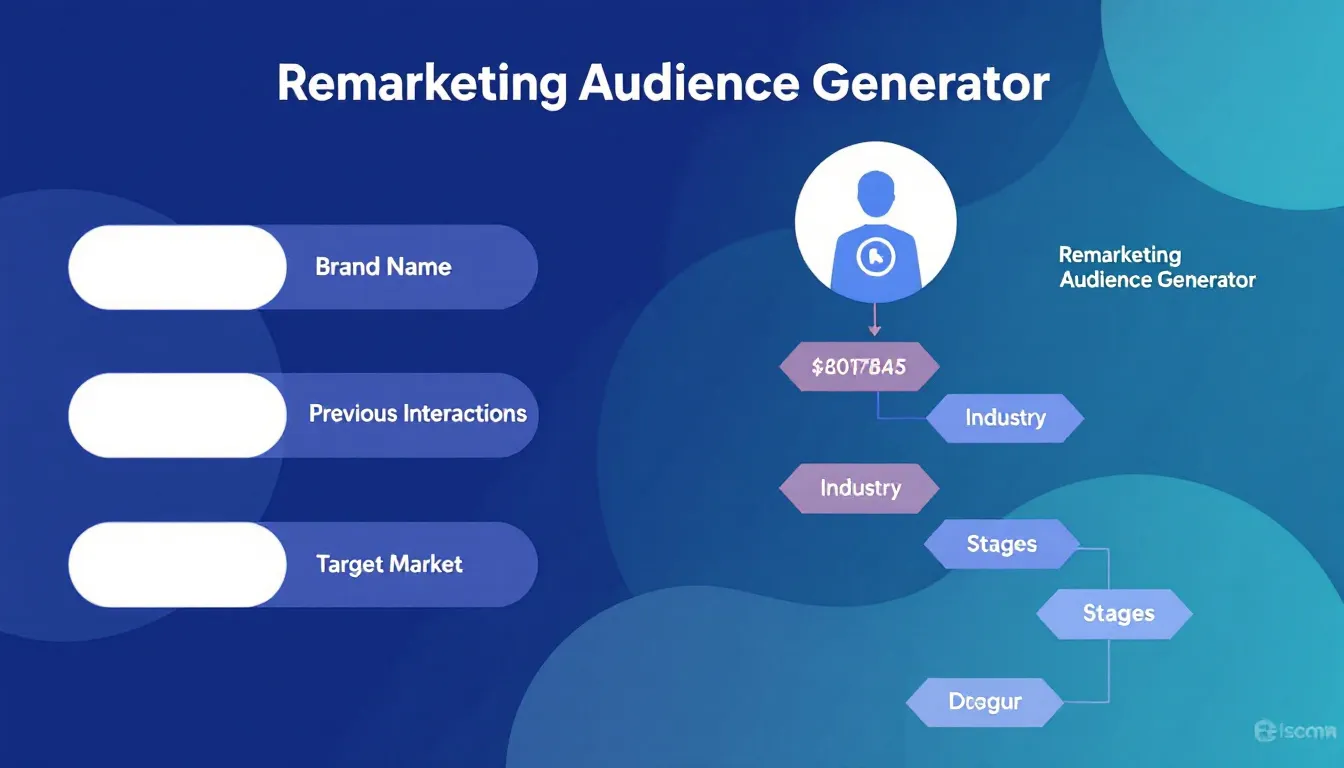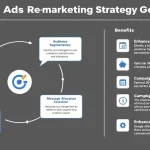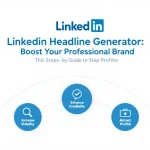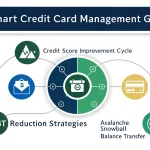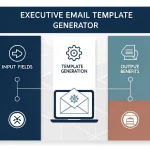Is this tool helpful?
How to Use the Remarketing Audience Generator Tool Effectively
Use this tool to create targeted remarketing audiences for your paid search campaigns by providing detailed inputs. Follow these steps to get the best results:
- Brand Name: Enter your company or product name. Examples: “GreenPath Outdoors” or “SmartHome Solutions”.
- Previous Customer Interactions: Describe how customers have engaged with your brand across channels. Examples include “Email subscribers with 50% open rate, users who watched product demo videos, repeat buyers in the last 3 months” or “App users with weekly logins, attendees at recent webinars, social media followers with high engagement.”
- Industry: Optionally, specify your business sector to help tailor audience suggestions. Examples: “Outdoor Recreation” or “Home Automation”.
- Target Market: Optionally, describe your ideal customer demographics. Examples: “Active adults aged 28-45, coastal regions” or “Tech enthusiasts aged 20-35, urban professionals.”
What is the Remarketing Audience Generator and How It Helps Your Marketing
The Remarketing Audience Generator helps you build precise audience segments based on your customers’ previous interactions with your brand. By analyzing engagement patterns, the tool suggests specific groups to target in your paid search campaigns, improving campaign focus and efficiency.
Purpose and Benefits
- Improve targeting accuracy: Reach audiences who already show interest.
- Boost conversion rates: Focus your budgets on higher-value prospects.
- Save time: Automate audience research and segment creation.
- Enhance campaign ROI: Increase return on ad spend by narrowing focus.
Practical Usage and Applications of the Tool
This tool streamlines audience creation based on your input data. It doesn’t perform calculations but transforms your descriptions into meaningful remarketing segments to enhance your ad targeting.
Use Cases
E-commerce Abandoned Cart Recovery
- Target users who left items in their shopping carts but did not check out.
- Send personalized offers or reminders to encourage purchases.
- Reduce lost sales and increase revenue by focusing on engaged visitors.
Service Provider Client Engagement
- Reach people who visited service pages or downloaded resources.
- Re-engage past clients with new offers or updates.
- Strengthen relationships and drive repeat business.
B2B Lead Nurturing
- Focus on users who downloaded whitepapers or attended webinars.
- Build targeted campaigns that convert interested professionals.
- Accelerate the sales funnel by maintaining contact with leads.
Key Elements of Effective Audience Generation
- Customer Engagement Analysis: Identify important customer touchpoints across multiple channels.
- Behavioral Segmentation: Group users by actions like website visits, purchases, or email interactions.
- Interest-Based Targeting: Focus on user interests inferred from previous behaviors.
- Customer Journey Mapping: Understand user paths and target based on different engagement stages.
Benefits You Gain Using This Audience Generator
1. Increased Campaign Performance
Targeting already interested customers improves:
- Click-through rates (CTR)
- Conversion rates
- Return on ad spend (ROAS)
- Cost efficiency per campaign
2. Advanced Audience Segmentation
Use detailed data to segment audiences based on:
- Purchase history and frequency
- Depth of website interactions
- Engagement on different marketing channels
- Cross-channel behavioral patterns
3. Time and Resource Efficiency
- Eliminate manual audience research
- Quickly generate ready-to-use audience segments
- Reduce overall campaign setup time
- Simplify audience management tasks
Addressing Common Marketing Challenges
Recovering Lost Sales Due to Cart Abandonment
Example: A company selling specialty teas wants to re-engage users who left carts:
- Brand Name: “TeaTime Delights”
- Previous Interactions: “40% cart abandonment, newsletter readers, social media contest participants”
- Industry: “Gourmet Food and Beverages”
- Target Market: “Tea lovers aged 25-50, suburban areas”
Boosting Brand Awareness in Niche Markets
Example: A startup producing eco-friendly office supplies wants to grow its reach:
- Brand Name: “EcoOffice Essentials”
- Previous Interactions: “Blog subscribers, product reviewers, sustainability conference attendees”
- Industry: “Eco-Friendly Products”
- Target Market: “Environmentally aware professionals, ages 22-40, metropolitan locations”
Frequently Asked Questions About Remarketing Audiences
Which businesses benefit most from this tool?
Businesses with an online presence like e-commerce brands, service providers, B2B companies, and local shops can all enhance their paid search campaigns using this tool.
How often should I refresh my remarketing audiences?
Update your audiences every 2 to 4 weeks to keep them aligned with shifting customer behaviors and maintain campaign effectiveness.
Can I create multiple audience segments at once?
Yes, you can generate several remarketing audience segments tailored to different goals or customer journey stages.
What is the ideal frequency for remarketing ads?
Start with moderate frequency caps, such as displaying ads every 3 to 7 days, then adjust based on how your audience responds.
How do I measure the success of my remarketing campaigns?
Track metrics like conversion rate, return on ad spend (ROAS), click-through rate (CTR), and overall engagement to evaluate performance.
Can I combine remarketing with other targeting methods?
Yes, you can layer remarketing audiences with demographic, geographic, or interest-based targeting for better campaign precision.
Is remarketing effective in B2B marketing?
Remarketing works well for B2B, especially when focusing on leads or decision-makers who engaged with your content or website.
How long should users stay in remarketing audiences?
Retention time depends on your industry and sales cycle. Consumer products typically use 30 to 180 days, while B2B services might retain users up to 365 days.
Important Disclaimer
The calculations, results, and content provided by our tools are not guaranteed to be accurate, complete, or reliable. Users are responsible for verifying and interpreting the results. Our content and tools may contain errors, biases, or inconsistencies. Do not enter personal data, sensitive information, or personally identifiable information in our web forms or tools. Such data entry violates our terms of service and may result in unauthorized disclosure to third parties. We reserve the right to save inputs and outputs from our tools for the purposes of error debugging, bias identification, and performance improvement. External companies providing AI models used in our tools may also save and process data in accordance with their own policies. By using our tools, you consent to this data collection and processing. We reserve the right to limit the usage of our tools based on current usability factors.
